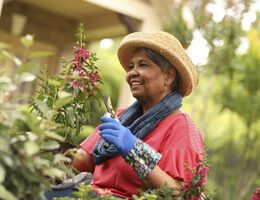Health library
Back to health libraryWant to age well? Sit less

July 11, 2024—You might think that if you aren't pumping iron at the gym or playing pickleball, it's pointless to get up off the sofa. But a new study published in JAMA Network Open suggests that even light physical activity can have big benefits for older adults.
Here's what the new research says about how to boost your health.
Even light activity helped health
The study used data from 45,176 women who answered questions about their activity levels as part of the Nurses' Health Study. Researchers followed participants ages 50 and older for up to 20 years to see how sedentary behaviors and light-intensity physical activity affected health as participants aged.
They found that sedentary behavior, like watching TV, was linked with reduced odds of healthy aging. But replacing an hour of TV watching with even light-intensity physical activity—which could be as low-key as walking around the house—increased the odds of reaching age 70 without chronic physical or mental health conditions.
Here's a look at some key takeaways:
- Each two-hour block of light activity was linked with a 6% increase in the odds of healthy aging.
- Each additional two hours per day spent watching TV was associated with a 12% reduction in the odds of healthy aging.
- Among participants who slept seven hours a day or less, replacing TV time with sleep also increased the odds of healthy aging.
Even small steps had significant benefits. The researchers found that replacing even one hour of screen time daily with light physical activity improved the chances of healthy aging.
Small changes add up
Incorporating more light activity into your daily life doesn't have to be daunting. Simple actions can make a difference. That includes activities such as:
- Carrying groceries.
- Cooking.
- Gentle yoga.
- Standing while you fold laundry.
- Tai chi.
- Walking the dog.
Light-intensity activity is likely part of your day already. But as the recent study showed, moving more—and sitting less—can help your health. To add more activity to your routine, try these tips from the American Cancer Society.
- Take short walks when you get the chance, even if it's just around your home or office.
- Find opportunities to stand. If you usually sit down to fold laundry, try doing it on your feet.
- Spend time in your garden pulling weeds and planting bulbs.
- When you park the car, choose a spot far from the front door to get some extra steps in.
- March in place during commercials. Stretch while you watch TV.
Step up to bigger benefits
While light activity is clearly good for you, increasing your intensity can offer even more benefits. For most adults, 150 minutes of moderate-intensity exercise per week is a good goal, according to the Centers for Disease Control and Prevention.
You might try:
- Brisk walking.
- Playing doubles tennis.
- Raking the yard.
How do you know if an activity is moderate-intensity? Try the talk test: During moderate-intensity exercise, you should be able to talk but not sing.
Moderate activity is safe for most people. But if you've been inactive or have any health conditions, talk to your healthcare provider before starting any exercise routine.
This study is a good reminder that you don't need to feel the burn to get the benefits of keeping active. Move in any way that works for you. Even small changes can add up to healthier aging.
Take the first step
You don't need to speed-walk to count your stroll as exercise. Find out what "brisk" really means with this short video.
